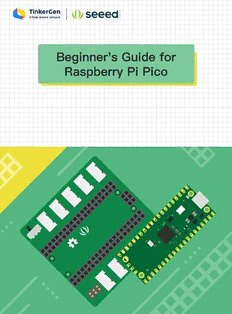Table Of ContentCatalog
Preface ..................................................................................................................1
Unit 1 Getting started ........................................................................................6
Lesson 1 Introduction to Hardware .........................................................8
Lesson 2 Introduction to Software .......................................................13
Unit 2 Hardware and Programming ................................................................22
Lesson 3 First Project: Light up LED ...................................................24
Lesson 4 Hello World in Electronic Hardware Programming: Blink .32
Lesson 5 Digital Signal in Circuit — Playing with LED ..................40
Lesson 6 Analog Signal in Circuit (1) — Rotary Angle Sensor ........48
Lesson 7 Analog Signal in Circuit (2) — the Use of PWM.................56
Lesson 8 Make Buzzer Sing — the Use of Function .........................64
Lesson 9 Journey of Data Visualization — the Use of LCD ..............74
Unit 3 Project Practice .....................................................................................84
Lesson 10 Temperature and Humidity Monitoring .............................86
Lesson 11 Intelligent Fan........................................................................94
Lesson 12 Intelligent Light ...................................................................102
Lesson 13 Automatic Door ..................................................................114
Lesson 14 Welcome Device .................................................................122
Unit 4 Expansion Projects ............................................................................130
Lesson 15 Create Your Own Projects ................................................132
Lesson 16 Project Presentation ..........................................................138
1
Preface
Raspberry Pi Pico is a microcontroller board based on the Raspberry Pi RP2040
microcontroller chip. It is designed as a low-cost, high-performance microcontroller board with
flexible digital interfaces. In the field of MCUs, Raspberry Pi Pico has become one of the most
popular topics recently. To help beginners get started with Raspberry Pi Pico quickly, we are
releasing the Starter Guide of Raspberry Pi Pico Based on MicroPython. Through four chapters
and a total of 16 lessons of study, this course can help you get started with Raspberry Pi Pico
easily. With its help, you can learn MicroPython from scratch, and build some interesting projects.
You don't need to have knowledge of MicroPython programming or electronics to begin. The
course will take you through learning this knowledge step by step, and quickly put it into practice
in each project.
2 Beginner's Guide for Raspberry Pi Pico
The first unit is an introduction to basics, which presents the hardware and software required
for the course. In the hardware portion, we need to understand the functions and features of
Raspberry Pi Pico, and the basic functions of Grove Shield for Pi Pico and Grove modules. In
software, we need to understand the concepts of Python and MicroPython, learn the installation
and use of the Thonny integrated development environment or IDE, and write our first program to
output characters through serial port: Hello World.
The second unit continues with more basic electronic hardware knowledge. We will learn
the basic syntax of MicroPython, various conditional statements, operators, variables and other
programming knowledge, and how to set the pins of electronic hardware through the standard
library. We will understand digital and analog signals in the circuit and be able to control the
electronic module to achieve different effects. At the same time, we will learn to use third-party
libraries and form a basic hardware programming knowledge framework through project practice.
The third unit begins project practice. We will integrate applications with real world scenarios
and realize various prototypes through different electronic module combinations and programming,
such as temperature and humidity monitoring, intelligent fan, intelligent light, etc. In this way, we
can skillfully apply what we have learned to life, and in so doing practice and develop project
thinking.The fourth unit outlines the steps to develop your own self-research project. We will use
the knowledge and skills learned before to complete the project production and show the results
at a project conference.
The specific framework is as follows:
3
4 Beginner's Guide for Raspberry Pi Pico
5
The course uses Pico's Grove Starter Kit, including Grove Shield for Pi Pico and common
Grove modules, which can enable quick project protyping without jumper wires and welding, and
consolidate the learned knowledge in practice. Because the Grove Starter Kit does not include
the Raspberry Pi Pico itself, we will need to prepare the following two kits before the start of the
course.
Raspberry Pi Pico Basic Kit:
• Raspberry Pi Pico * 1
• USB cable * 1
• 20 Pin Header * 2
• 3 Pin Header * 1
Grove Starter Kit of Raspberry Pi Pico:
• Grove - Light Sensor
• Grove - Sound Sensor
• Grove - Mini PIR Motion Sensor
• Grove - Temperature & Humidity Sensor
• Grove - Rotary Angle Sensor
• Grove - Button
• Grove - LED Pack
• Grove - RGB LED (WS2813 Mini)
• Grove - Passive Buzzer
• Grove - Relay
• Grove - 16x2 LCD
• Grove - Servo
• Grove - Mini Fan
Purchase link:
Grove Starter Kit of Raspberry Pi Pico
Raspberry Pi Pico Pre-Soldered
Visit the following URL to get the codes& Libraries:
Codes: https://files.seeedstudio.com/wiki/Grove_Shield_for_Pi_Pico_V1.0/Codes.rar
Libraries: https://files.seeedstudio.com/wiki/Grove_Shield_for_Pi_Pico_V1.0/Libraries.rar
Are you ready? Our journey with Raspberry Pi Pico and MicroPython is about to begin.
6 Beginner's Guide for Raspberry Pi Pico
Unit 1
Getting started
7

